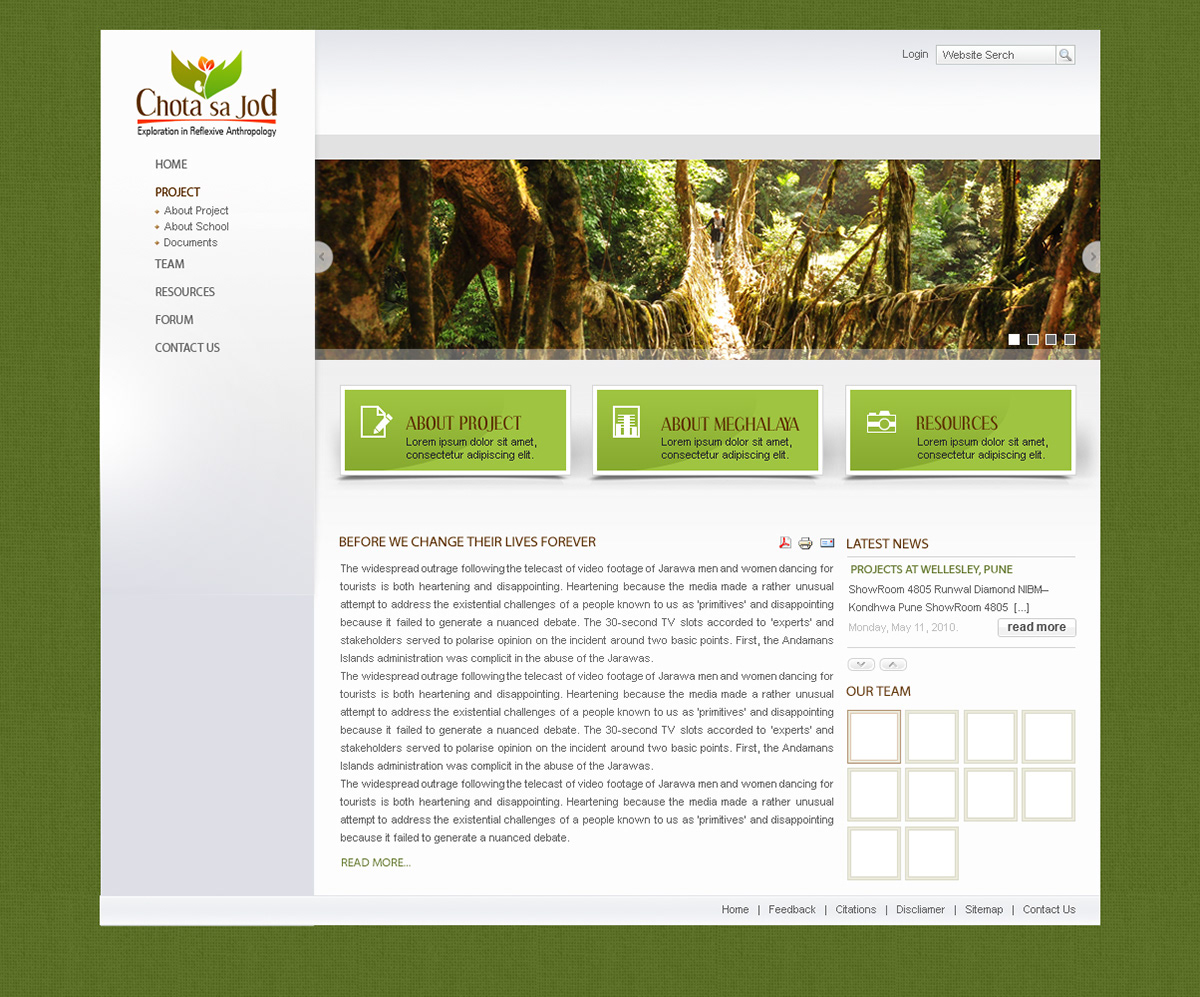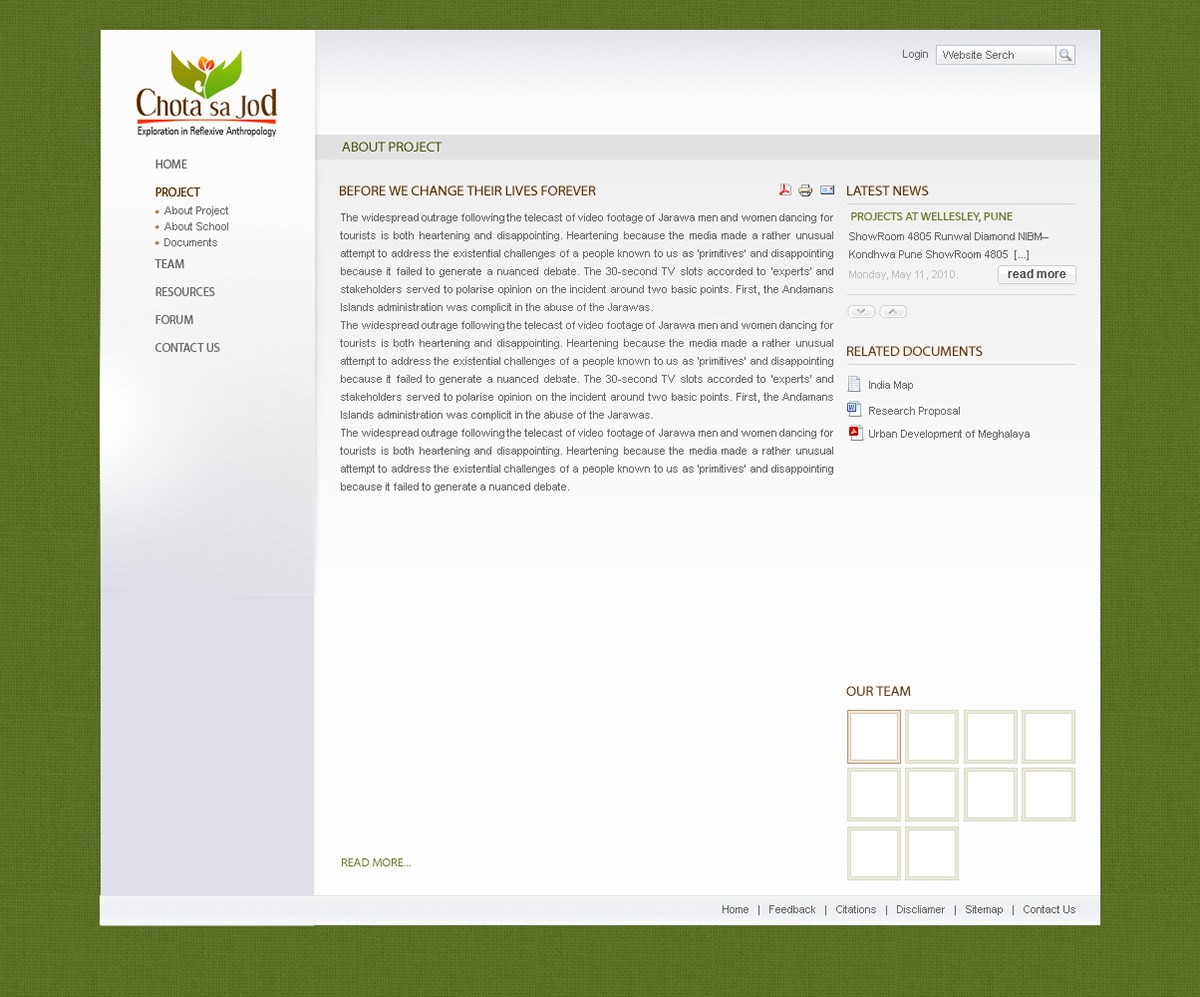Chota sa Jod
Exploration in Reflexive Anthropology
The project hopes to explore new ways of class room learning by designing a communication framework that integrates distinct anthropological methods in conjunction with readily available technologies.
The project aims to augment the teacher’s role in encouraging the students to explore. What we are trying to convey are ideas and concepts which are often alien to the class environment; so where ideally the students would have needed to move to these contexts to engage. Our motivation is to bring these interactions to the classrooms themselves.
For this purpose we have chosen the issue of sustainable designs. Mawlynnong in Meghalaya is a typical place to see this in action. The travel magazine Discover India declared the village as the cleanest in Asia in 2003, and the cleanest in India in 2005. It has the presence of a Living Root Bridges. Urban society could learn a lot from Mawlynnong and its environmentally conscious citizens. The self sustaining models though rudimentary, have very strong foundations and have more to do with behavior and customs that the peoples have adhered to and upheld. All these aspects put together may point that people utilize culture, knowledge and traditional resources to design and live with it.
Exploration in Reflexive Anthropology
The project hopes to explore new ways of class room learning by designing a communication framework that integrates distinct anthropological methods in conjunction with readily available technologies.
The project aims to augment the teacher’s role in encouraging the students to explore. What we are trying to convey are ideas and concepts which are often alien to the class environment; so where ideally the students would have needed to move to these contexts to engage. Our motivation is to bring these interactions to the classrooms themselves.
For this purpose we have chosen the issue of sustainable designs. Mawlynnong in Meghalaya is a typical place to see this in action. The travel magazine Discover India declared the village as the cleanest in Asia in 2003, and the cleanest in India in 2005. It has the presence of a Living Root Bridges. Urban society could learn a lot from Mawlynnong and its environmentally conscious citizens. The self sustaining models though rudimentary, have very strong foundations and have more to do with behavior and customs that the peoples have adhered to and upheld. All these aspects put together may point that people utilize culture, knowledge and traditional resources to design and live with it.
THE BACKGROUND:
The travel magazine Discover India declared Mawlynnong in Meghalaya as the cleanest village in Asia in 2003 and the cleanest village in India in 2005. But that is not it’s only claim to fame. Mawlynnong is also the site of the extraordinary Living Root Bridges. And lastly, but by no means the least, Meghalaya and especially the provinces of Mausinram and Cherrapunji are best known for being (perhaps) the wettest place on Earth. Incessant rainfall and turbulent river streams make it a difficult place to live indeed. And it is this violent and unforgiving face of Nature that the Living Root Bridges help to tame. These bridges are constructed out of the inter-tangling of roots from trees planted adjacently on opposite banks of a stream; taking several generations, sometimes up to 500 years to build. After consulting text books (mainly Geography and Environmental Science) we decided that this would be the perfect scenario to demonstrate this idea.
THE TECHNOLOGY:
We will be working with such technological tools as the portable video projector, a laptop computer and a broadband internet connection; things which are fast becoming (or already are) properties found in all private schools and major public schools in our country today.
THE EVENT:
Our project is sending a group of three elected members to Mawlynnong in Meghalaya, from where these members will be reporting via internet video chat to the school students. This is the central point of our project. The rest of the team will remain here and assist the children frame their questions, and keep informing them on the latest developments outside the chat sessions. But these 1-2 hour live video sessions will give the children a chance to walk through the site and ‘see the place for themselves’.
THE PROCESS AND PLAN:
For purposes of structure and efficiency, we will start gathering questions and requests from the students from before the three member video crew leaves for Meghalaya. This will require anything between one to three days, depending on practicalities.
We anticipate that a lot of the questions and doubts raised in the first round will be answerable sitting here in Gandhinagar, Gujarat. Therefore, we will organize a presentation which will answer most if not all of those questions.
By this we hope to create a ground level of understanding among the students about the conditions in Mawlynnong, Meghalaya; but also, at the same time, to ensure that they are framing questions that best exploit the possibilities offered by the project i.e. the live video conferencing.
This exercise will be conducted over another one to three days.
The other motivation behind this is encouraging the students themselves to act as ethnographers. And in some sense aren’t we all?
THE SPIRIT OF ETHNOGRAPHY (AND THE RATIONALE OF THIS PROJECT):
The spirit of Ethnography is perhaps best captured in the word ‘Exploration’. And there was a time not too long ago, when the world was still being ‘discovered’. It was as if travel equals knowledge. Men like Columbus and Marco Polo were charting out voyages to unknown lands; ‘seeing’ things and reporting back stories of adventure.
And it was this re-narrating the adventures; showing something through the recounting of one’s own experiences that exercised a certain sense of power.
But the days of ‘discovery’ are gone. In the age of the Internet, few things (if not nothing) remain(s) undiscovered. Therefore, doing ethnography by seeing something and reporting on it is not so novel any more.
What one is concerned with now is the ‘subjectivity’ of observation, the ‘subjectivity’ of representation and finally the ‘subjectivity’ of reception. That is why the subtitle of the project reads ‘Explorations in Reflexive Anthropology’.
The travel magazine Discover India declared Mawlynnong in Meghalaya as the cleanest village in Asia in 2003 and the cleanest village in India in 2005. But that is not it’s only claim to fame. Mawlynnong is also the site of the extraordinary Living Root Bridges. And lastly, but by no means the least, Meghalaya and especially the provinces of Mausinram and Cherrapunji are best known for being (perhaps) the wettest place on Earth. Incessant rainfall and turbulent river streams make it a difficult place to live indeed. And it is this violent and unforgiving face of Nature that the Living Root Bridges help to tame. These bridges are constructed out of the inter-tangling of roots from trees planted adjacently on opposite banks of a stream; taking several generations, sometimes up to 500 years to build. After consulting text books (mainly Geography and Environmental Science) we decided that this would be the perfect scenario to demonstrate this idea.
THE TECHNOLOGY:
We will be working with such technological tools as the portable video projector, a laptop computer and a broadband internet connection; things which are fast becoming (or already are) properties found in all private schools and major public schools in our country today.
THE EVENT:
Our project is sending a group of three elected members to Mawlynnong in Meghalaya, from where these members will be reporting via internet video chat to the school students. This is the central point of our project. The rest of the team will remain here and assist the children frame their questions, and keep informing them on the latest developments outside the chat sessions. But these 1-2 hour live video sessions will give the children a chance to walk through the site and ‘see the place for themselves’.
THE PROCESS AND PLAN:
For purposes of structure and efficiency, we will start gathering questions and requests from the students from before the three member video crew leaves for Meghalaya. This will require anything between one to three days, depending on practicalities.
We anticipate that a lot of the questions and doubts raised in the first round will be answerable sitting here in Gandhinagar, Gujarat. Therefore, we will organize a presentation which will answer most if not all of those questions.
By this we hope to create a ground level of understanding among the students about the conditions in Mawlynnong, Meghalaya; but also, at the same time, to ensure that they are framing questions that best exploit the possibilities offered by the project i.e. the live video conferencing.
This exercise will be conducted over another one to three days.
The other motivation behind this is encouraging the students themselves to act as ethnographers. And in some sense aren’t we all?
THE SPIRIT OF ETHNOGRAPHY (AND THE RATIONALE OF THIS PROJECT):
The spirit of Ethnography is perhaps best captured in the word ‘Exploration’. And there was a time not too long ago, when the world was still being ‘discovered’. It was as if travel equals knowledge. Men like Columbus and Marco Polo were charting out voyages to unknown lands; ‘seeing’ things and reporting back stories of adventure.
And it was this re-narrating the adventures; showing something through the recounting of one’s own experiences that exercised a certain sense of power.
But the days of ‘discovery’ are gone. In the age of the Internet, few things (if not nothing) remain(s) undiscovered. Therefore, doing ethnography by seeing something and reporting on it is not so novel any more.
What one is concerned with now is the ‘subjectivity’ of observation, the ‘subjectivity’ of representation and finally the ‘subjectivity’ of reception. That is why the subtitle of the project reads ‘Explorations in Reflexive Anthropology’.
Background Research: the people, their history, their beliefs, their lifestyle and so on.


LOGO DESIGN: the idea behind the making of "chota sa Jod" Logo
The central visual of the logo is composed of leaves and a seed. Two leaves which are bigger in size and colored in green, resemble of the eco-friendly aspect that this project is going to focus on. Also they denote the cover sleeves of a book to show the involvement of school and how this project is going to impact the learning methods followed in a school. The two big leaves also form the shape of two caring hands, which shows its protection attitude towards "chota" leaves - which this projects cars for the relation we made with the school kids and also a small attempt for the betterment in ways of teaching. The title is in brown - the color of the wood (bamboo/roots) that is used to construct the bridges. Finally there a bridge that is used to cross the rivers. This placed in between the title and the tag-line.
Website Design:
The central visual of the logo is composed of leaves and a seed. Two leaves which are bigger in size and colored in green, resemble of the eco-friendly aspect that this project is going to focus on. Also they denote the cover sleeves of a book to show the involvement of school and how this project is going to impact the learning methods followed in a school. The two big leaves also form the shape of two caring hands, which shows its protection attitude towards "chota" leaves - which this projects cars for the relation we made with the school kids and also a small attempt for the betterment in ways of teaching. The title is in brown - the color of the wood (bamboo/roots) that is used to construct the bridges. Finally there a bridge that is used to cross the rivers. This placed in between the title and the tag-line.
Website Design:


